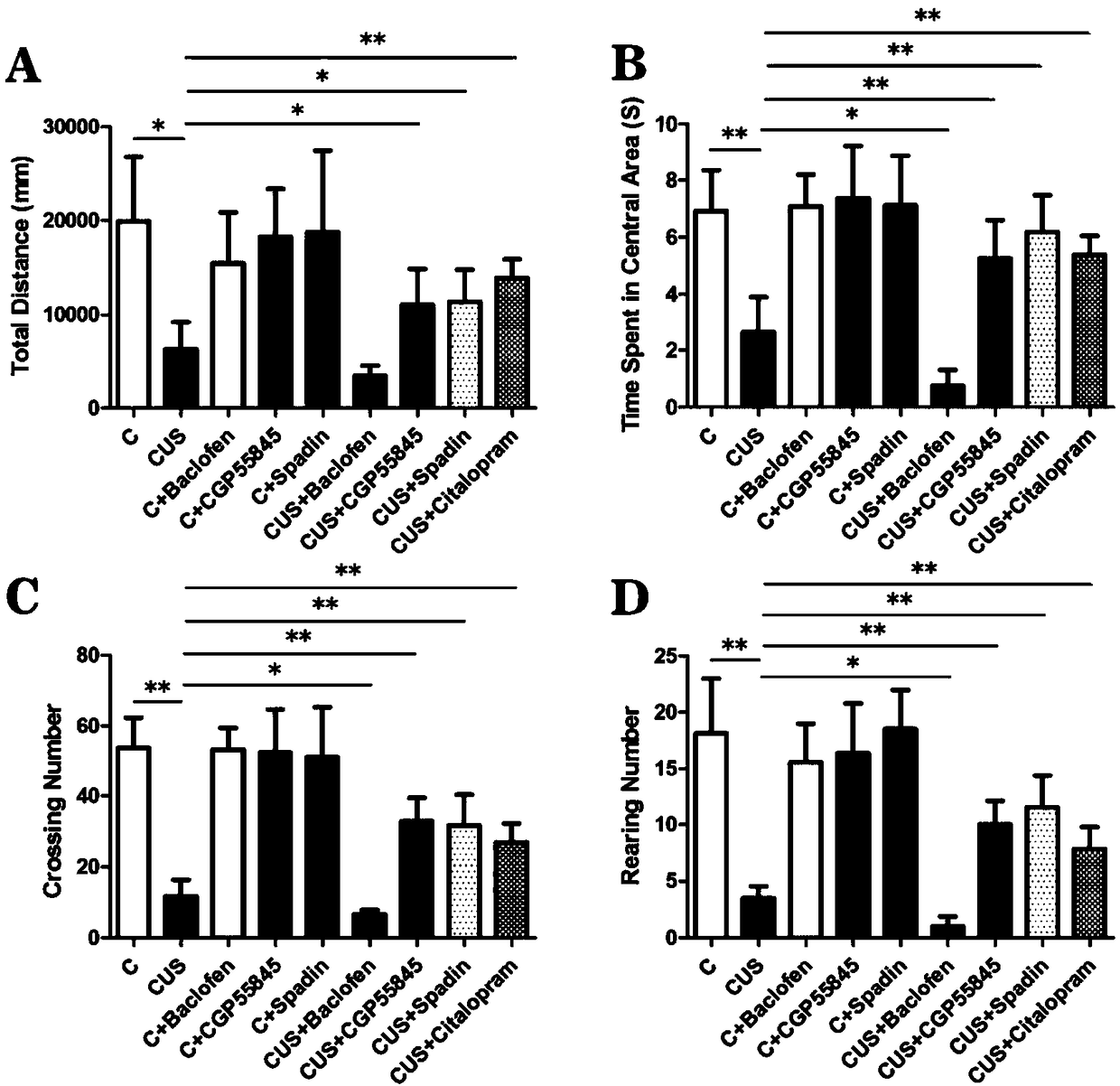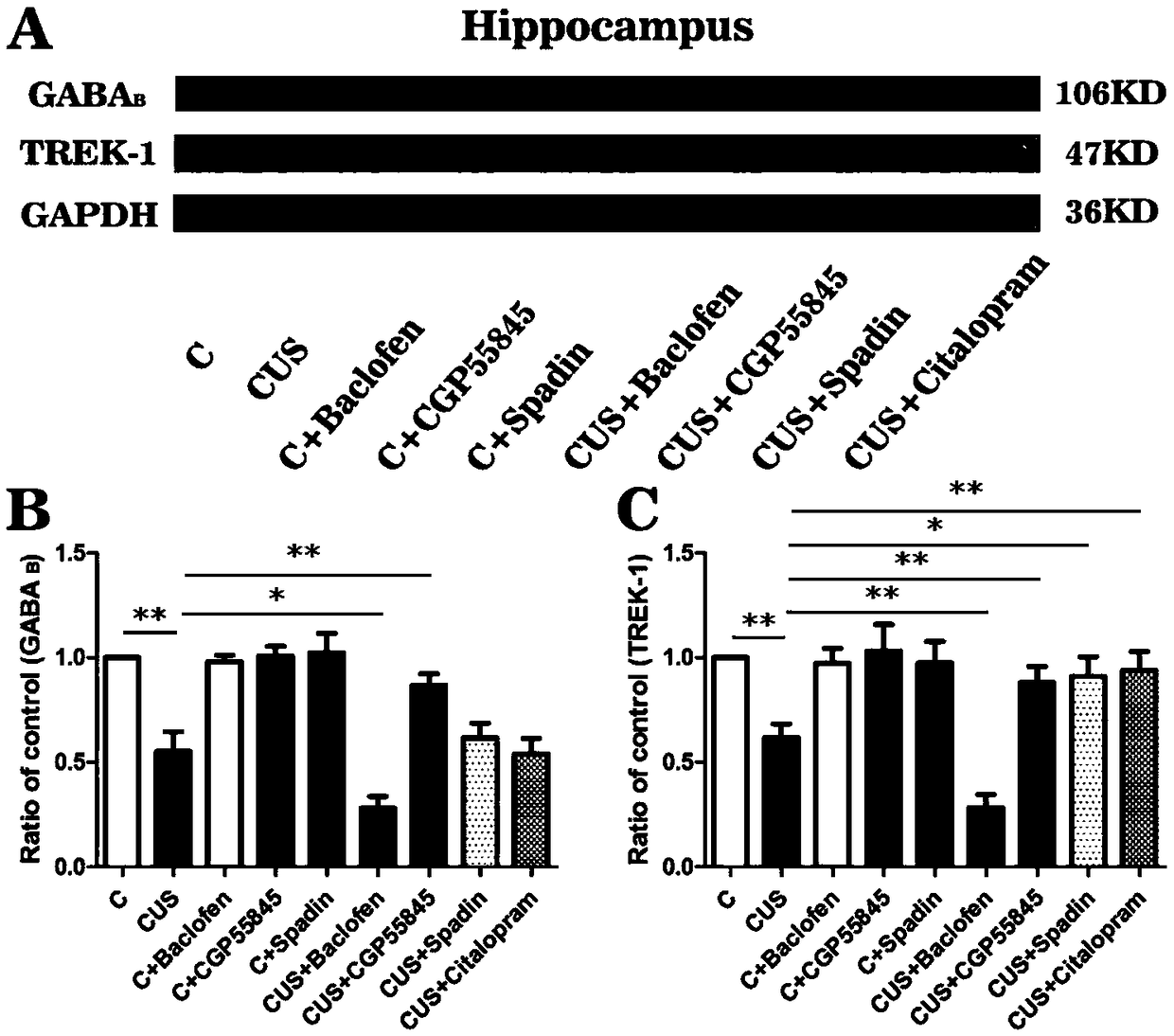Application of GABAB receptor antagonist in aspect of blocking TREK-1 channel
A technology of receptor antagonists and channels, applied in the application field of GABAB receptor antagonists in blocking TREK-1 channels, can solve the problems of inability to achieve antidepressant treatment, increase the complexity of the onset of depression, the complexity of pathogenesis, etc. question
- Summary
- Abstract
- Description
- Claims
- Application Information
AI Technical Summary
Problems solved by technology
Method used
Image
Examples
preparation example Construction
[0141] 3 Preparation of chronic stress-stimulated depression model
[0142] According to Katz and Willner’s improved method, a chronic unpredictable stress (CUS) model was prepared with chronic unpredictable stress. All rats were kept in cages with a diurnal cycle, with 8 rats per cage, and the rats were given freedom before the experiment. Diet, adapt to the environment for a week. The breeding environment is suitable, temperature: 22±1°C, humidity 55%-60%. After the environmental adaptation, the model group gave rats a stimulus every day for 27 days, and each stimulus would not appear continuously within two days. The stimulus types included: 30 minutes of restraint, 24 hours of fasting, 24 hours of water deprivation, and 15 minutes of warm water swimming (31°C), 10 minutes of cold water swimming (18°C), 24 hours of single-cage feeding, 24 hours of moist bedding with a 30° inclined cage, 10 minutes of mouse tail clipping (1 cm from the root of the tail) and overnight lighti...
Embodiment 1
[0144] Behavioral testing - open field test (OFT)
[0145]The open field test, also known as the open box test, is a method to evaluate the autonomous behavior, exploratory behavior and tension of experimental animals in a novel environment. The inner wall of the rat open field test box (90cm×90cm×40cm) is black, and the bottom surface is divided into 9 small squares (30cm×30cm) on average. In the animal behavior analysis system, the open field test box starts from the upper left and presses left to Right, top to bottom are numbered sequentially, of which 5 is the central area, and the rest are peripheral areas. A digital camera is set up 1 meter above, and its field of view can cover the entire open field. The open field lighting is fully artificial lighting (about 40LX) to avoid light interference. The experiment was carried out in a quiet environment. Experimenters and computers and other equipment were placed in another room to reduce interference with animal behavior. T...
Embodiment 2
[0150] Behavioral testing - sucrose preference test (SPT)
[0151] The sugar water preference test is a behavioral experimental method used to evaluate the degree of anhedonia in rats. Since anhedonia can best reflect the core symptoms of depression, this experiment can reflect the degree of depression in rats to a greater extent. Referring to relevant literature, rats need to be trained to learn and adapt to drinking sucrose water before the formal start of the experiment. Two bottles of 1% sucrose water should be placed in each cage, and the rats should try to drink sucrose water for 24 hours first; then in the second 24 hours, each cage should be replaced with a bottle of pure water and a bottle of 1% sucrose water for normal rats. Among them, the left and right positions of two water bottles need to be replaced in 12 hours; in the last third 24 hours, two bottles of normal rats are placed in each cage to drink pure water. After the sucrose water acclimatization, there wa...
PUM
 Login to View More
Login to View More Abstract
Description
Claims
Application Information
 Login to View More
Login to View More - R&D
- Intellectual Property
- Life Sciences
- Materials
- Tech Scout
- Unparalleled Data Quality
- Higher Quality Content
- 60% Fewer Hallucinations
Browse by: Latest US Patents, China's latest patents, Technical Efficacy Thesaurus, Application Domain, Technology Topic, Popular Technical Reports.
© 2025 PatSnap. All rights reserved.Legal|Privacy policy|Modern Slavery Act Transparency Statement|Sitemap|About US| Contact US: help@patsnap.com



